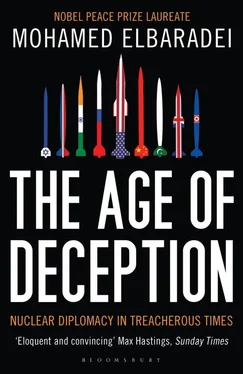Clearly intent on slowing down the process, Syria asked that additional questions or inspection requests be sent in writing. When the U.S. ambassador to the IAEA, Greg Schulte, came to see me in July, he referred to the destroyed facility as “a one-off thing.” It was obvious to me from his remarks that the Americans also were in no hurry to see a report on the Syrian nuclear program—apparently because of ongoing indirect talks between Syria and the United States. “You might have your own political agenda,” I told Schulte, “but the Agency’s agenda is quite different, and we take our responsibilities seriously.”
David Miliband, the British foreign secretary, also seemed to have no interest in seeing the Syria issue pursued further. When I briefed him on the Agency’s actions, he responded, “Oh, so you have done a full investigation?” This was not the case; I saw it as his way of indicating that he would prefer to see an end to the inquiries. I was not clear as to the motive, but my gut feeling was that even if Dair Alzour had been a reactor under construction, the threat was now eliminated and the West was eager to bring Syria, an ally of Iran, to their side. This impression of back-room political considerations was reinforced one year later: when Syria failed to accommodate various Western demands, the IAEA Secretariat was urged to pressure Syria by requesting a special inspection, although there was no obvious legal basis for such a request.
The results of the Agency’s environmental samples from Dair Alzour came back showing the presence of uranium that, while not enriched, had undergone some chemical processing. In the months that followed, the Syrians gave various explanations for this, beginning with the claim that the material must have come from uranium traces in the munitions used by Israel in the bombing. None of their explanations made complete sense or was verifiable. Israel, for its part, refused to provide the Agency with any information in their possession as to why they had bombed the facility.
Syria also refused to allow the IAEA to visit the three other sites allegedly related to the destroyed facility. They were military facilities, not nuclear related, we were told, and therefore the Agency had no reason to visit them. They also refused to show us where the debris from the destroyed facility had been taken.
During the June 2009 IAEA Board meeting, this stalemate—the result of withholding information from the Agency, and then assigning it the impossible task of verifying what no longer existed—led to a particularly direct confrontation. Once again, I urged Israel to share the information that had led it to use force against the Syrian facility at Dair Alzour. The Israeli ambassador to the IAEA, Israel Michaeli, complained, saying I was making “redundant” demands. Israel, he said, had already provided answers to the IAEA’s relevant questions, denying that the uranium traces could have come from Israeli munitions. [15] Israel had provided a one-line answer to the IAEA’s questions, merely saying that the source of the uranium found was not Israeli, not even acknowledging that it had been responsible for the actual bombing.
By pressing Israel to come up with more evidence of Syria’s nuclear program, Michaeli declared, I was showing a “political bias.” He also implied that because we had not called for a special inspection on Syria, the Agency was not using all the tools in its toolkit.
Michaeli was out of line, and he knew it, but I also knew he was acting under instructions from his capital. I answered him with a directness that shocked some of the delegates. His stance, I said, was “totally distorted.” By refusing to provide us with the necessary evidence, Israel was essentially obstructing the IAEA’s investigative process. I made my next remarks looking directly at him:
The representative of Israel… is mentioning that Syria should be deplored and condemned. But Israel, with its action, is to be deplored by not allowing us to do what we are supposed to do under international law…. You say we refrain from using tools. Israel is not even a member of the [nuclear nonproliferation] regime to tell us what tools are available to us. [Your country] cannot sit on the fence, making use of the system without being accountable…. We would appreciate it if you could stop preaching to us how we can do our jobs.
Regarding his accusation that I was biased, I said I would not even dignify it with a response.
We were stuck. Despite my repeated requests—including those made public in IAEA Board reports—Israel and the United States did not give us further evidence to substantiate their conclusion that the Dair Alzour facility had been nuclear. The Syrians continued to claim that it was not nuclear, but they refused to provide additional information or access to prove their contention.
Sometime later, I sent an appeal through a Syrian businessman with direct access to Syrian president Bashar al-Assad. I pressed for cooperation with the IAEA, making clear that the issue would continue to hang over Syria until it was cleared up. A message came back saying that al-Assad appreciated my efforts; curiously, what was missing was any denial that Dair Alzour had been a nuclear reactor site.
The hypocrisy could not have been clearer: for some Member States, nuclear proliferation concerns were tools to be used, hyped, or ignored according to geopolitical ends, depending on the relationship with the country in the stand.
The most fundamental problem with the nuclear nonproliferation regime is, in itself, a double standard: the inherent asymmetry, or inequality, between the nuclear haves and have-nots, exacerbated by the continuing reliance by the nuclear-weapon states on nuclear weapons and their lack of progress on nuclear disarmament. Worse, rather than moving to fulfill their commitment to disarm, most have modernized their arsenals and continue to develop new types of weapons. For countries that do not have such weapons and do not fall under a nuclear umbrella protection arrangement such as NATO, this reinforces the perception that the acquisition of nuclear weapons is a sure path to power and prestige, an insurance policy against attack.
The UN Security Council also is part of the problem, in part because of the veto power wielded by the P-5, the five nuclear-weapon states. The Security Council’s charge is to maintain international peace and security and to be responsive to threats against that peace and security. Certainly, some violations of an IAEA safeguards agreement may not rise to the level of requiring referral to the council. However, on those rare occasions when such referrals are made, the council should be appropriately responsive: it should be agile, resolute, forceful when needed, and above all, consistent in its actions.
By those standards, the record of the Security Council in responding consistently to nuclear threats has been abysmal. In 1981, after Israel destroyed Iraq’s Osirak reactor and the Security Council condemned the bombing, it also urged Israel to put its nuclear facilities under IAEA safeguards. Israel ignored the resolution, and the Security Council took no further action. In 1998, after the Indian and Pakistani nuclear weapons tests, the Security Council condemned the testing and asked both countries to cease the development of nuclear weapons and their delivery systems. When those resolutions were ignored, the council again backed off. In the case of North Korea, when the IAEA first reported North Korea’s noncompliance in 1993, and in 2003, when the country withdrew from the NPT altogether, the council took no meaningful action, instead letting the United States take the initiative through the Agreed Framework in the 1990s, and in the latter case deferring to China’s lead in setting up the six-party talks.
Читать дальше












